Archived Water Damage Blog Posts
How to Repair a Burst Pipe
11/14/2024 (Permalink)
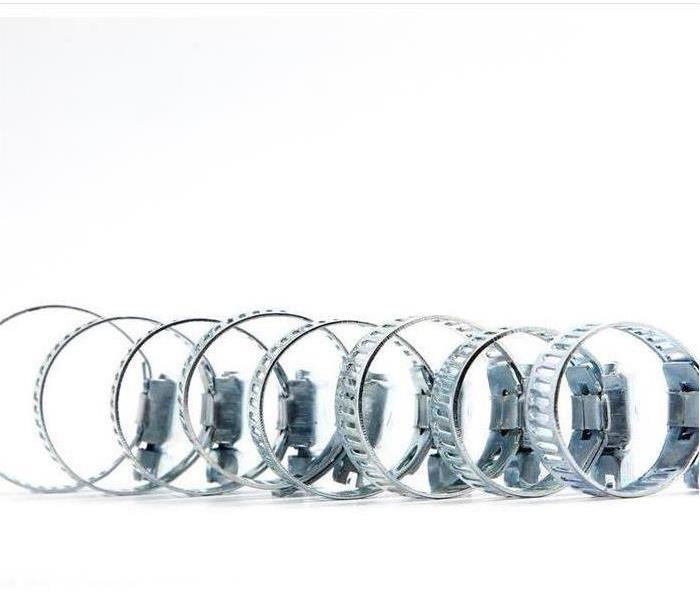 Fix a broken pipe by using metal clamps
Fix a broken pipe by using metal clamps
Bursting pipes can cause a lot of damage in a short amount of time, making them a scary issue for many homeowners. If your home in New Sweden, TX, is experiencing a pipe burst, chances are you will need to call a plumber to help resolve the issue. In the meantime, you can secure the leak using the following technique.
Fix Broken Pipe Using a Clamp and Sleeve
A clamp and sleeve kit can provide a temporary patch to stop the leak while you wait for remediation experts to arrive. Patch your bursting pipes using the following technique:
- Shut off the main water line. Use a metallic file or steel wool to smoothen any rough areas around the damaged section of pipe.
- Position the rubber sleeve so that it is centered over the burst. The clamp's seam should be facing the opposite direction of the break.
- Position the metal clamps around the rubber sleeve. Use a screwdriver to tighten the clamps.
- Reopen the water supply to the pipe. Watch carefully for any leaks.
The above technique should temporarily solve the issue while you wait for the plumber to arrive. If it doesn't fix the leak, simply repeat the process and reposition the clamp until it solves the issue.
Dry the Water
As soon as you stop the leak, you need to start drying the water. Standing water can quickly cause a lot of secondary damage, such as mold growth, so it's important that you act quickly. If the leak was small, you can resolve the issue by mopping up the water with a towel. Larger leaks that create a lot of water damage likely require professional assistance.
It's important that you take immediate action to fix bursting pipes as soon as you discover it. The subsequent water damage can wreak havoc on your home and cause several subsequent issues. Contact water remediation experts for help assisting with damage cleanup.
What to Do If a Toilet Overflows in Your Home
7/26/2024 (Permalink)
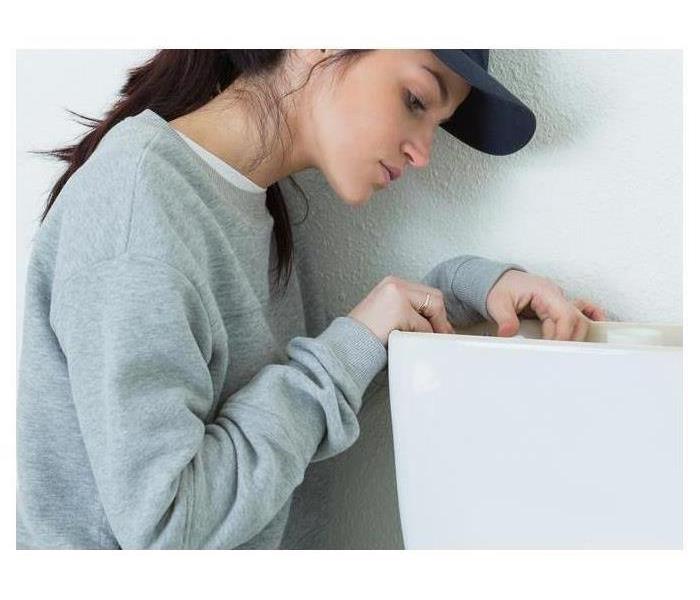 Open the tank and raise the float so that the inflow valve shuts off
Open the tank and raise the float so that the inflow valve shuts off
The world could be said to have entered the modern era around 1900 since this was when average homeowners started seeing flushing toilets become widespread for individual residences. Solutions to handling sewage before indoor toilets were inconvenient at best and frequently a public health disaster.
Unfortunately, when commodes don’t work right, it can feel like a throwback to the 19th century, potentially leaving you with widespread sewer damage in your home – and an unholy mess to face. Knowing how to handle it will make your life easier.
What Are the Types of Damage?
The sewer damage to your home will depend on the category of water damage:
- Category 1 is clean water with no waste.
- Category 2 is grey water with urine but no feces.
- Category 3 is black water with fecal material.
A flooded toilet with clean water will at least present no danger of contamination, although if it soaks into carpet, wood, or drywall, you may need professional help. Category two or three will almost always require an expert to disinfect the impacted areas and inspect for hidden water damage.
What Should You Do if It Happens?
First off, stop the overflow! Open the tank and raise the float so that the inflow valve shuts off. If necessary, turn off the water to the toilet. Remove standing water as fast as possible; if it’s a small amount of clean water and you remove it immediately you may not need to do anything else. If there’s sewer damage, excessive amounts or contaminated water, you’ll almost certainly need to consult with a local restoration company experienced in dealing with serious water damage.
Who’s Responsible for the Clean-Up?
In most cases, you’re the lucky one who deals with the mess. Unless your sewage company can be shown to have negligently caused a serious plumbing issue, the homeowner is responsible in Pflugerville, TX. In a multi-family unit, your landlord may share responsibility or be expected to handle the problem if the sewer line is shown to have serious issues. At the least, the immediate mess is always your problem.
Do Not Let Black Water Ruin Your Day!
4/17/2024 (Permalink)
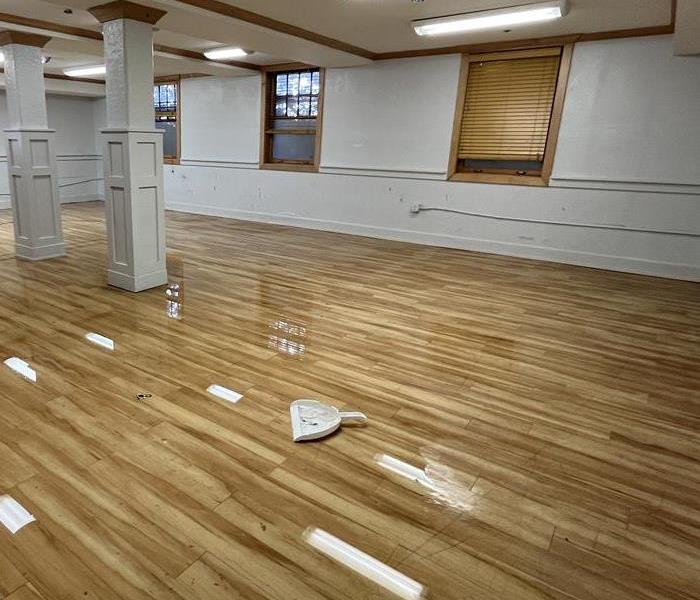 This flooded room was caused by a severe rain storm in Pflugerville, Texas. This picture shows standing water on a wood floor
This flooded room was caused by a severe rain storm in Pflugerville, Texas. This picture shows standing water on a wood floor
When home or business property in Pflugerville, Texas is flooded, it may have negative impacts on you. Flood water can damage equipment, furniture, files and merchandise. When hurricanes and heavy storms occur, flooding becomes an even bigger concern because the water typically causes sewer backups, which leads to bacteria-filled black water. Call SERVPROof Pflugerville when flood water damages your home or business.
Are there Different Types of Contaminated Water?
Experts classify water into three-categories to describe the level of contaminants in different types of water. The first category is “clean water,” which comes from a fresh supply line, such as a sprinkler system or sink faucet. The second category is “gray water,” which comes from sources like washing machine drains. This water is dirty but not highly toxic. “Black water” is the third and most dangerous category. Flood water, sewage and drain backups, and toilet overflows fall into this category because the contaminants in these waters are so toxic.
When your home or business property is affected by sewage water, it contaminates the air, floor and everything it touches. If not properly sanitized, unsafe water can continue to be harmful to people. Whether it is your home, retail property, manufacturing facility or warehouse, it can put people’s health at risk. Safety concerns can cause a business to have to close its doors, which only results in further loss.
What Can Be Done About Harmful Flood Water?
If you find yourself dealing with water damage, act quickly and call SERVPRO of Pflugerville. We are available 24-hours a day and will assess the damage, extract the water safely, remove contaminated articles, and sanitize the area according to IICRC standards for safety.
SERVPRO of Pflugerville should be your first choice for any residential or commercial water damage. Our team of professionals is trained to assess the damage, identify potential threats, and respond quickly to restore your property to preloss condition. SERVPRO of Pflugerville is available 24/7 by calling 512-990-4776
4 Causes of Crawl Space Flooding in Your Home
11/3/2023 (Permalink)
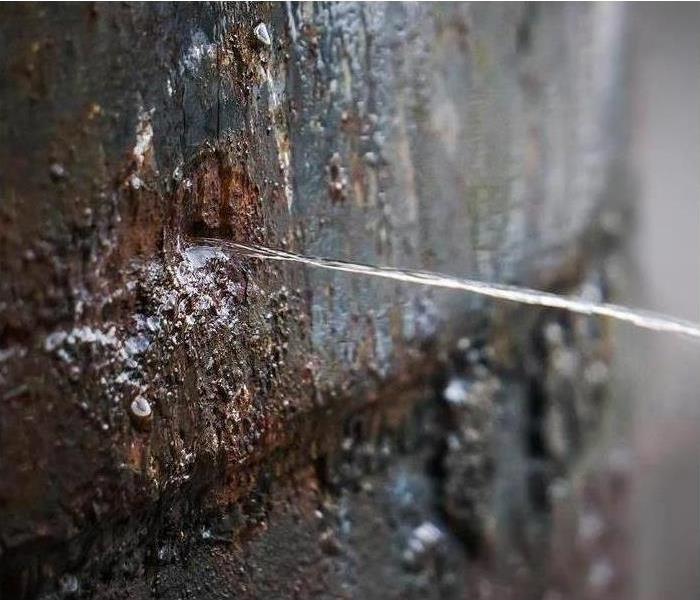 If a pipe cracks or bursts in your home, the water will ultimately flow into the lowest space in your house.
If a pipe cracks or bursts in your home, the water will ultimately flow into the lowest space in your house.
A wet crawl space may seem like a minor issue. However, if left untreated, it could lead to mold growth in your Austin, TX, home. A persistent flow of water in the crawl space could also spread to the main part of your house.
That is why you should regularly check this part of your home for signs of excess water. You should also take steps to prevent these common causes of crawl space flooding.
Downspout Problems
A downspout aimed too close to your home can cause water buildup in your crawl space. Point your downspout away from the foundation of your home and add a splash block to guide the water away from your property.
Over-Watered Flower Beds
You may not think of your flower bed as a potential cause of a wet crawl space. But overwatering of your plants does not only cause them to die. It can also lead to a flood in your home. To prevent this problem, put base layers into your flowerbeds to catch excess water.
Poor Slope Grading
If the landscape outside your home is not sloped properly, water will flow back into the crawl space. The slope should be six to eight inches away from the walls of the foundation. Winter snow and ice can change the sloping, so be sure to check the grading each spring.
Broken Water Lines
If a pipe cracks or bursts in your home, the water will ultimately flow into the lowest space in your house. Keep your eye out for any obvious puddles or wet areas on your property, as these may point you to the location of the ruptured pipe.
If you can't find the leaky pipe or the cause of your wet crawl space, emergency restoration professionals can help. They will not only locate and stop the source of the water, but they can also clean and dry any damaged items or structures.
Mitigating Water Damage After a Water Heater Fails
7/27/2023 (Permalink)
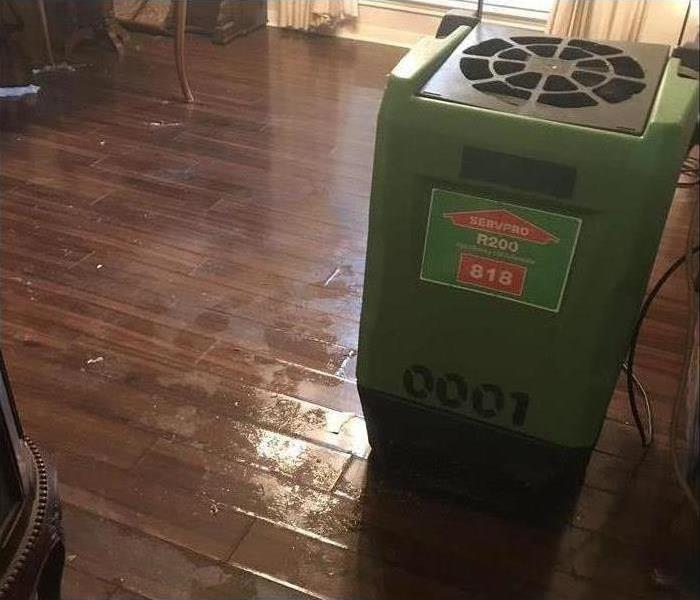 Mitigating water damage in a Cele, TX home
Mitigating water damage in a Cele, TX home
Mitigating Water Damage After a Water Heater Fails
A failed or leaking water heater can cause significant damage to your property, especially if it had gone unnoticed. These devices can lead to major flooding in homes and will probably require a mitigation and restoration company in Cele, TX, to clean and repair your system and property. Any company you call will typically follow the same procedure.
Shut off water supply
Remove equipment and water
Dehumidify the area
Remove damage
Restore property
Shut Off Water Supply
After experiencing a failed water heater, you will need to address the situation quickly to avoid significant damage. Before calling for help, you should find the water shutoff valve to stop the continued flow of water from the heater.
Remove Equipment and Water
Once the restoration company arrives, they might first assess the damage to your property before removing the broken water heater and extracting the excess water. To remove the flood, they will typically use shop vacs, pumps and possibly special trucks with built-in suction pumps, depending on the depth of the flooding.
Dehumidify the Area
After the leaking water heater and the flood are removed, the team will get to work drying and dehumidifying the affected space. It is necessary to make sure that the structure of the home is completely dry before getting to work on any repairs.
Remove Damage
While the space is drying, the restoration company will probably be removing damaged items as well as any structural damage like drywall or insulation. The removal of drywall is sometimes necessary, especially with significant flooding, because the wall cavities could have been exposed to excessive moisture, which may lead to mold.
Restore Property
Once the area is dry and all damage has been removed, the company you hired will begin restoring the property. Restoration companies are experts in returning your home to pre-disaster conditions, which means you will see no evidence of flood when they are done.
While a leaking water heater may not lead to a full-blown disaster, a failed tank can. If you experience such a failure, then seeking out a restoration professional might be your best option.
Cleaning Your Home After Water Damage
4/24/2023 (Permalink)
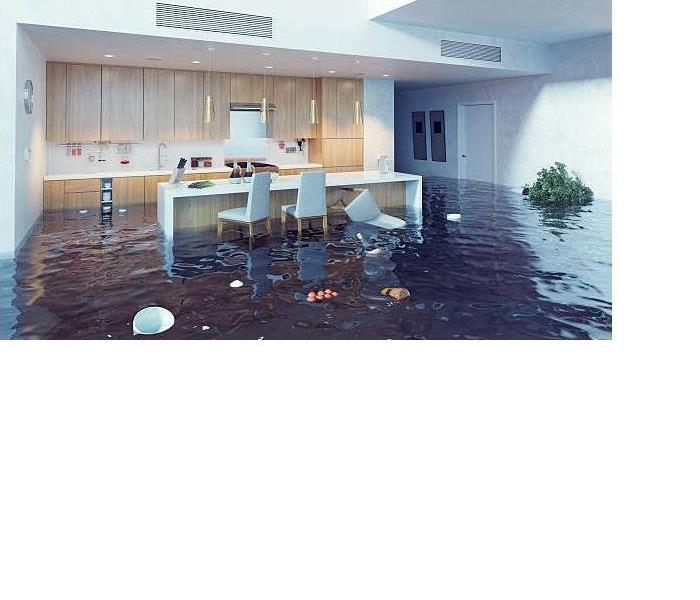 If you suspect contaminated water is involved, such as in a sewer backup, contact a company that is Here to Help.
If you suspect contaminated water is involved, such as in a sewer backup, contact a company that is Here to Help.
Many scenarios exist for homeowners where water leaks or floods into a residence. Some of these can be tackled in a DIY fashion, while others require the services of an expert storm remediation company. Recognizing the severity of a situation can save time and money and protect the health of you and your family members. The instances that lend themselves to DIY solutions are limited to a water source that is clean and potable, and to a problem that is small in scope. A sewer backup, on the other hand, involves a potentially dangerous water source and should be handled by technicians who wear PPE and are trained in techniques to take care of dirty water.
Big Jobs Demand Expertise
If your home, is affected by a water problem, it sometimes makes more sense to call in a local team. Technicians can arrive at your home in a matter of hours and begin to assess the property. The following situations are best handled by experienced personnel:
- Sewer backup
- Broken sewer pipe
- Flooding
- Complicated job
- Toilet overflow
- Septic system malfunction
Contaminated water is present in most plumbing issues. Flood waters that enter a home might contain harmful chemicals, sewage, and animal waste. A bathtub backup is another example of dirty water escaping where it does not belong. An experienced technician will understand the techniques and equipment necessary to treat the problem.
Small Jobs Allow DIY
A small leak of clean water can be handled without calling in reinforcements. This includes situations such as the leak of drinking water or a water spill onto carpeting. The best plan is to stop the source of the leak and then to dry out any items with fans or increased ventilation. It's important to completely dry out surfaces to prevent mold from taking hold in the near future.
What Should You Do If a Pipe Bursts?
11/5/2022 (Permalink)
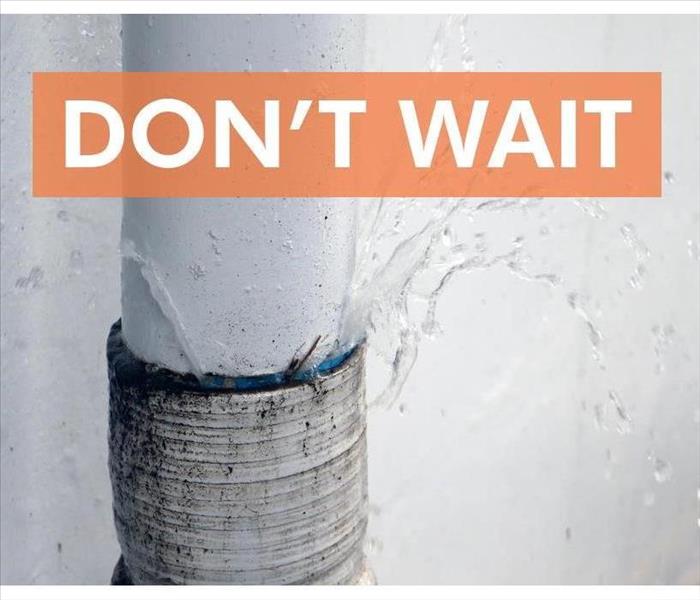 If you have a pipe burst, it is best to call cleanup professionals right away.
If you have a pipe burst, it is best to call cleanup professionals right away.
How Do You Respond If a Pipe Bursts?
If you've ever had a burst pipe in your Pflugerville, TX, home, you know that it can be a stressful situation. You want to make sure the damage is contained, but also that it doesn't become worse by causing mold or other problems. SERVPRO of Pflugerville can help with this! Here's what you need to know if this happens in your home:
1. Shut off the water
It's important to shut off the main water valve before beginning work on a burst pipe. If you aren't sure where your main water valve is located, call someone who can help you locate and shut it off. This will prevent further damage to your house while you repair the broken pipe.
2. Shut off the electricity
The next step is to shut off the electricity. Turn off the breaker box and don't touch any electrical equipment that you think may be wet or electrified. If you're not sure how to do this, call a professional.
3. Call your insurance company
To handle a burst pipe, you'll need to call your insurance company immediately. If you have a homeowner's policy with renter's coverage for plumbing and heating repairs, then your insurance company will pay for any damages caused by a burst pipe. This includes replacing your belongings that were damaged in the flood.
It also covers replacing items like flooring and cabinets if they got soaked by water from a broken pipe. If you live in an old house with original hardwood floors and they get ruined after flooding occurs due to busted pipes, that will fall under this category!
4. Call cleanup professionals right away
If you have a pipe burst, it is best to call cleanup professionals right away. Mold can start growing within 24 hours of a water leak, so you don’t have much time before mold begins to grow. Additionally, if the water damage is severe enough that you are unable to clean it yourself, using professional help will save you time and money in the long run. A water cleanup professional can usually take care of the entire insurance claims process for you, so that you don’t have to stress about it.
Call SERVPRO of Pflugerville
When you need help with water damage cleanup, SERVPRO of Pflugerville should be your first call. We’re a trusted name in the industry, having helped people find solutions to their problems for many years. Our team is available 24/7 to help you get started on the path toward restoring your property back to its pre-damage condition. We offer quality services like mold removal and water damage restoration so that no matter what happens at your property, our team can make it right again. If you have any questions or need our water damage cleanup and restoration services, don’t hesitate and give our SERVPRO of Pflugerville team a call today!
How To Prevent Secondary Damage Before and After a Flood
7/30/2022 (Permalink)
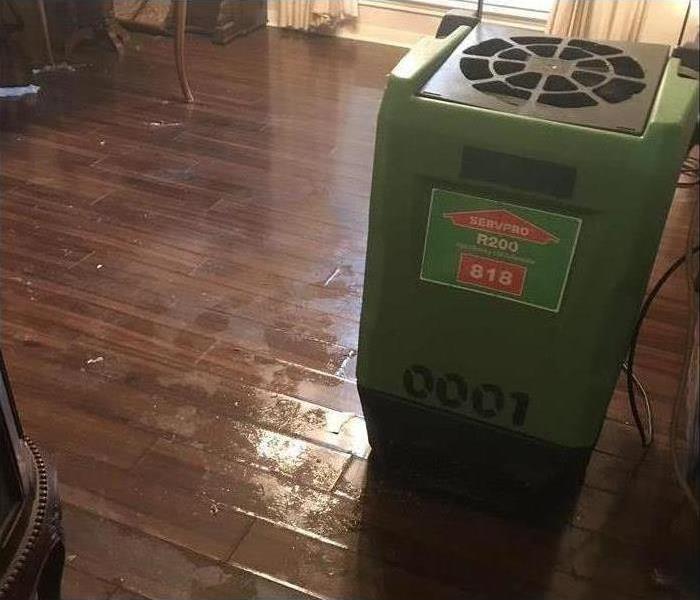 Try investing in a dehumidifier, which takes water out of the air.
Try investing in a dehumidifier, which takes water out of the air.
Here Is How You Can Minimize Said Damage Before And After A Flood
A flood in Austin, TX, can be a detriment to homeowners if not properly handled. This isn't just in terms of immediate or primary damage. If the water isn't properly removed, a large amount of secondary flood damage can occur, often in the form of black mold. This type of damage refers to any issues that occurred after the flood. Here is how you can minimize said damage before and after a flood.
Before
While preventing secondary damage may not be a priority before a flood, it may be prudent to take some precautions that minimize water intake. One of the main ways to do so is by making a few changes to your home. These are some structural modifications you can perform:
- Elevating your home
- Sealing any cracks
- Planting foliage to block water
- Using water-resistant materials
Other than adapting your home, you can also prepare by planning and gathering supplies. Plastic flood wraps can help to protect sensitive areas of the residence, as well as valuable property. If you invest in pumps or large fans, the cleanup process will be far easier. You should also have a plan should a flood occur. Know what objects to elevate and what area to direct the residents towards.
After
Once a flood occurs, time is of the essence. Black mold is liable to occur if decisive action isn't taken, both before and after a flood restoration service arrives. Your main priority is to remove the water from your residence. Make use of any supplies you have. If a pump isn't available, use buckets. When the standing water is gone, begin drying the affected areas. Use towels and any fans you have. The immediate solutions aren't the only ones that should be taken. Unremoved water will likely result in high humidity, which can greatly service mold growth. Try investing in a dehumidifier, which takes water out of the air.
Secondary flood damage isn't a determined event. You can minimize it by acting quickly. This will help to prevent black mold and other issues. Flood damage may be harrowing, but it doesn't have to be long-lasting.
3 Steps To Take After a Pipe Break
5/18/2022 (Permalink)
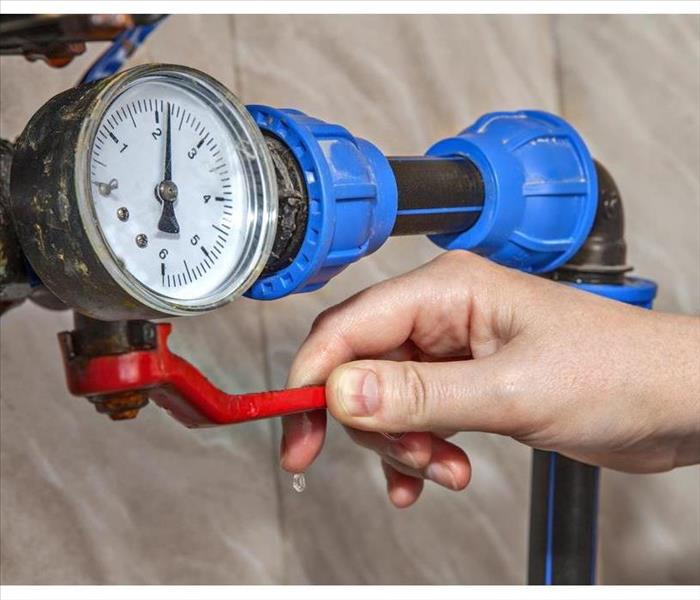 It is important that you first shut off your home's water.
It is important that you first shut off your home's water.
3 Steps After a Pipe Break
Handling the aftermath of bursting pipes in your Cele, TX, home can feel like a daunting job. Standing water, wet building materials and damaged personal items can make you feel overwhelmed; however, there are a few steps you can take to minimize these problems as you wait for help to arrive.
1. Turn Off the Water
Before you can examine or fix broken pipe parts, it is important that you first shut off your home's water. This helps reduce the amount of standing water in affected areas. The valve is likely located inside your house in a location that faces your street. If the valve is in an area affected by an indoor flood, exercise caution when entering the area, especially if a burst toilet pipe is the cause.
2. Contain the Water Damage
In many cases, bursting pipes cause widespread problems when the flow of water enters other rooms. You can protect your furniture and other items by trying to contain the water as best you can. For example, if your bathroom sink's main pipe is the culprit, close the bathroom door after you shut off the water and seal the bottom with towels. Keep kids and pets away from flooded rooms so they do not undo any seals you create.
3. Keep Humidity Low
While you wait for a water cleanup and restoration company to arrive, you can reduce the risk of mold growth in flooded rooms by opening windows and using fans to keep air circulated. Mold can develop as soon as 24 hours after a flood, so doing all you can to keep the humidity low may stunt its growth.
When bursting pipes affect your Cele, TX, home, the resulting flood can leave you worried about many different types of damage. Knowing which steps to take when the problem occurs may reduce the risk of serious foundation or mold issues later on.
How Secondary Damage Can Make Commercial Flooding Worse
3/10/2022 (Permalink)
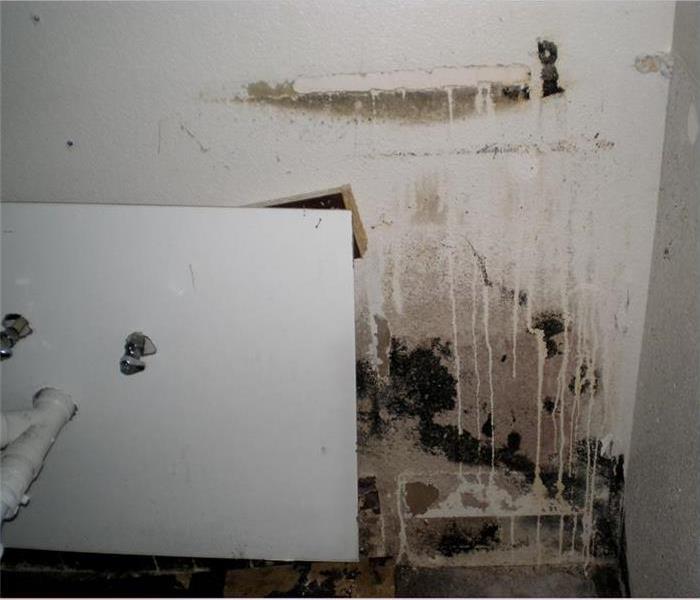 Water can lead to mold growth if not treated immediately
Water can lead to mold growth if not treated immediately
How Secondary Damage Occurs?
If your business floods, your first concern may be the rising water itself. While this is certainly a problem, it’s also important to avoid secondary damage. The increased levels of humidity in the room can cause black mold to spread. Here are a few ways you can avoid this problem after a flood in Austin, TX:
- Call a restoration company immediately
- Thoroughly clean all damaged items
- Keep an eye out for signs of mold for a few weeks after restoration
It’s essential for business owners to follow each of these steps to stop the damage. Furthermore, understanding how secondary damage occurs can help you avoid it.
Plenty of Humidity
Even a few inches of water can significantly increase the humidity levels in a room. This high humidity means that there is a lot of water in the air. That moisture in the air then sticks to the walls, surfaces, and furniture in the area.
Moisture Leads to Mold
When the water in the air lands on particular surfaces, it can begin to grow black mold. Unfortunately, that means that the mold grows in places where you may not expect it.
How does moisture make mold? Mold spores are all around us. However, without the necessary water levels, they don’t grow into anything dangerous. Once humidity rises in your business, those previously harmless mold spores become a problem.
The Clock is Ticking
The very second water spills into your business, you’re on a timer to prevent mold and other problems. In most cases, you have only 24 to 48 hours until the mold is visible. This is one of the reasons it is important to call a restoration company immediately.
Black mold and other secondary damage can make flooding in your business worse than it already would have been. Be sure to contact a restoration company in Austin, TX as soon as you see signs of flooding and avoid this problem altogether.
Cleaning Up Your Home After Water Damage
2/9/2022 (Permalink)
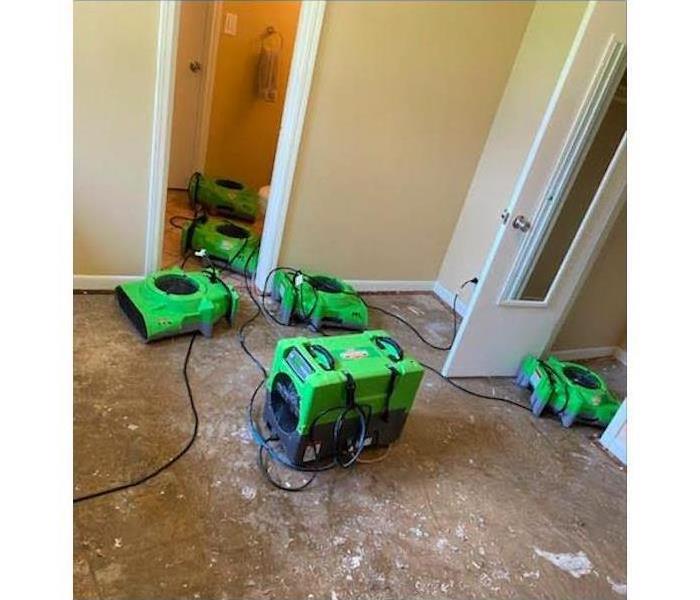 Drying bedroom from water damage.
Drying bedroom from water damage.
Water Restoration Process
While water is healthy to drink and useful for cleaning and bathing, it can cause devastating damage if you have to deal with broken pipes. Not only may you lose valuable and sentimental personal belongings before you begin water cleanup, but water damage can also render appliances useless, cause mold to grow and ruin sheetrock and insulation. The restoration process can be long and difficult, but following the five steps listed below can help make the process easier.
1. Remove remaining water. The longer standing water stays in your home, the more damage it can cause. It is important to remove any water as quickly as possible to allow the building to completely dry. Depending on how much water remains in your home, you can use any one of the following items to remove it:
- Sump pump
- Trash pump
- Wet vac
- Buckets
- Towels
2. Assess the damage. Once the water has been removed, you can see the extent of the damage. You may have to tear out carpet to remove mold, rip out sheetrock and replace it, and scrub multiple surfaces and materials to get rid of bacteria.
3. Remove mold and damaged materials. If water damage has caused mold to grow, it is important to remove the fungus as soon as possible. Evaporating moisture and treating the area with antifungal spray may help rid your home of mold.
4. Clean non-porous items. After removing any traces of mold, you can begin the final, most time-consuming stages of cleanup. Any items that do not absorb water, such as furniture, counters, toys, or storage containers, that came in contact with the water need to be scrubbed thoroughly with warm water and disinfectant to remove potentially-harmful germs.
5. Clean porous items. Items that may have absorbed water should be cleaned thoroughly to keep them from mildewing. Porous items may include anything from the following list:
- Curtains
- Stuffed animals
- Clothes
- Bedding
Dealing with water damage in Cele, TX can be overwhelming, but following these five steps can make water cleanup easier. Broken pipes may be your worst nightmare, but the damage can be repaired with the right tools.
A Water Hammer Can Cause a Pipe Break in Your Home
12/29/2021 (Permalink)
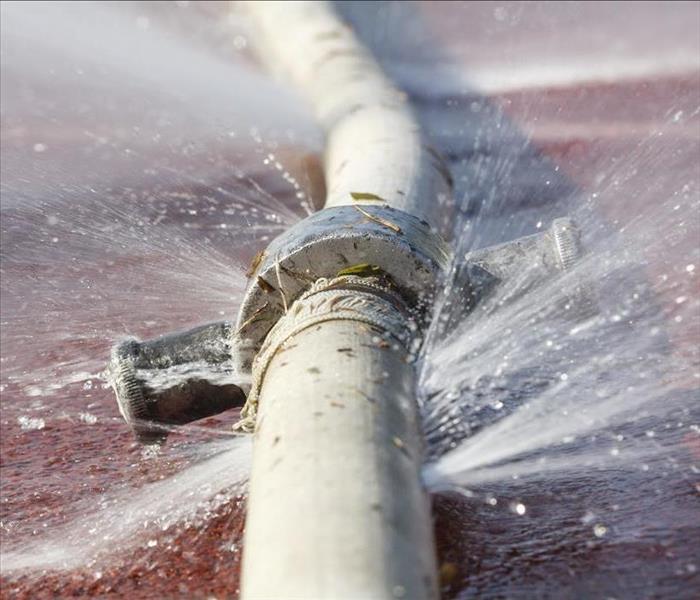 A water hammer is more than just noisy.
A water hammer is more than just noisy.
A Water Hammer Can Cause a Pipe Break in Your Home
Imagine that you open the cold-water faucet in your kitchen sink and let the water run. The water is moving quickly from the pipes in the street to the open kitchen faucet. That moving water has a lot of momentum. Next, imagine quickly shutting off that faucet. The moving water comes to a complete stop and hits the closed faucet with the force of a hammer. That is a water hammer.
A water hammer is more than just noisy. It beats away at your plumbing day after day, shaking your pipes and looking for a weak spot. In time, it will find that weak spot and cause a pipe to burst. There are several things you can do to deal with your water hammer and minimize the chances of a pipe break.
1. Call the water department. If you think that your water pressure is dangerously high, complain. Perhaps they have some way to lower the water pressure entering your home. After all, you can’t be the only one in New Sweden, TX with this problem.
2. Secure all the pipes in your home. The sound made by a water hammer is the vibration of your plumbing. That sound may not seem like much, but the motion behind it can loosen plumbing joints over a long period. The loose pipes may require tightening pipe hangers, installing new ones and placing shims.
3. Solve the water hammer problem with plumbing modifications. Water hammer arrestors can reduce the water hammer effect. Pressure reduction devices can lower the water pressure in your home. Install these, and you may never know what it is like to fix a broken pipe.
Be Prepared for the Day a Pipe Break Occurs
If a pipe breaks in your home, there is no telling when or where it will happen. All you can do is be prepared. Just know that there are qualified water damage experts ready to help. They are just a phone call away.
What You Need To Know About Moisture and Building Materials
11/29/2021 (Permalink)
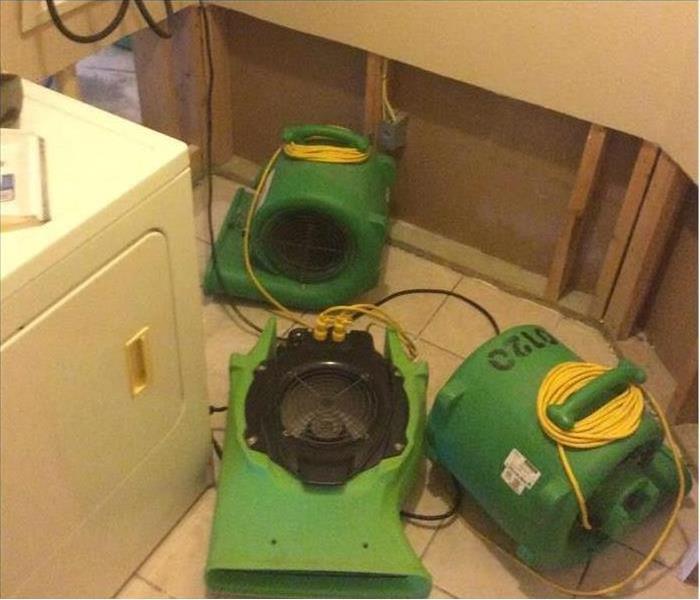 Residential water damage in Austin, TX.
Residential water damage in Austin, TX.
Moisture and Building Materials: What You Should Know
When homebuilders in Austin, TX, construct a private residence, they use a variety of building materials. As you likely know, these materials are mostly dry when they leave the production facility. Unfortunately, during and after construction, materials can encounter moisture. While flooding can cause swelling wood, it does not necessarily destroy all types of building materials.
Consider the Type of Building Material
To determine whether excess moisture has destroyed building materials, you must think about the type of building material involved. In virtually all houses, the following types of materials exist somewhere:
- Wood
- Carpeting
- Drywall
- Tile
- Metal
- Glass
As you may suspect, some of these materials resist water damage better than others. When water touches wood, it often swells. Flood remediators usually address swelling wood by removing it altogether. This is often the case with cabinetry, subfloor, and manufactured-wood materials. Still, some real-wood building materials eventually dry out. Likewise, drywall can often be dried. Carpeting tends to dry as well. Thus, if your carpet sustained damage from a leaky supply line or other clean-water sources, you probably don’t have to replace it. Tile, metal, and glass are generally impervious to floodwaters.
Stop the Flood
Before you can think about throwing away or saving building materials, you must identify the source of the leak. In many residences, damaged water pipes are the culprit. By contracting with a skilled plumber in Austin, TX, you can likely achieve a successful water pipe repair.
Simply because you notice swelling wood does not mean you need to haul all the materials in your home to the landfill. Deciding whether your building materials are salvageable may be beyond your expertise. Fortunately, you don’t have to go it alone. By working with a reputable restoration service, you benefit from industry expertise. You also take advantage of professional-grade equipment and skill to restore your home’s value, condition, and livability.
Baby, It’s Cold outside: Monitoring Your Building for Frozen Pipes
9/27/2021 (Permalink)
 If frozen pipes are left unchecked, they can lead to burst pipes in your building which can cause extensive water damage.
If frozen pipes are left unchecked, they can lead to burst pipes in your building which can cause extensive water damage.
The winter months in Austin, TX, are hard on business owners, but more importantly, they are hard on your building. Your pipes are the most vulnerable to colder weather. If not adequately insulated, the water inside your pipes can freeze, leading to broken pipes and water damage. Since a costly water cleanup is most likely not on the list of any business owner, it is essential to know what to look out for in case of freezing.
1. No Water
If there is no water coming out your faucets, or the water is a slow trickle, your pipes may be frozen. When water freezes, it creates blockages of ice, which do not allow the free flow of water and which can cause excess pressure on the pipe, leading to a potential burst.
2. Odors
While it may seem strange, if strange smells or odors are permeating from your faucets or drains, it can mean that there is an ice blockage. When water freezes in waste pipes, it does not allow odors to escape or ventilate the way that they are expected to, and this leads to the strange smells coming from areas that they are supposed to.
3. Frost
You should check your mechanical closets and look for the presence of frost because this can be a reliable indicator that there is ice build up in your pipes, and if this is left unchecked your pipes can burst which will require a timely cleanup to prevent further water damage.
4. Temperature
The most reliable indicator of frozen pipes is any one of the above in combination with temperatures below 32°F, as water does not freeze above this.
If frozen pipes are left unchecked, they can lead to burst pipes in your building which can cause extensive water damage. It is better to keep an eye out for the signs and to act quickly in the event of a freeze.
How To Unclog a Drain in 4 Steps
6/29/2021 (Permalink)
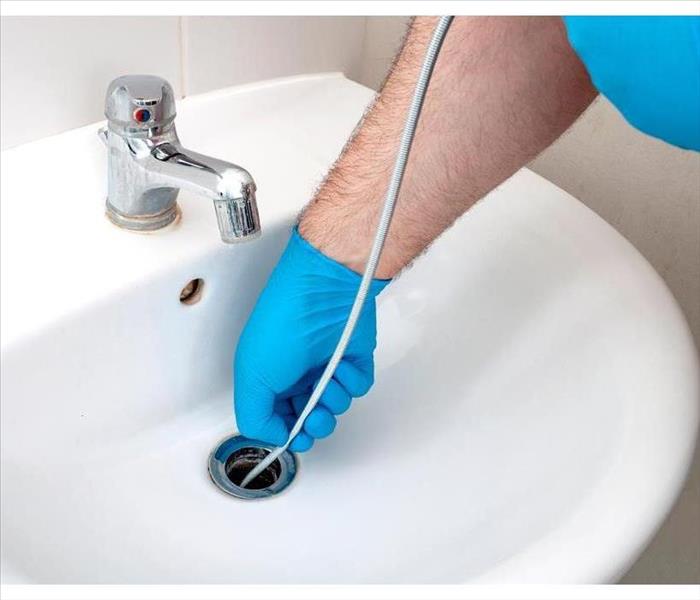 If you have a clogged drain in your home you may have to use a drain snake to release it.
If you have a clogged drain in your home you may have to use a drain snake to release it.
Four Steps To Use A Snake Effectively
Just about everyone has been there. You turn on the faucet to brush your teeth, and the water doesn't drain properly. You step out of the shower to dry off, and there is still water standing. When you have a clogged drain in your home in Cele, TX, you may have to use a drain snake to release it.
1. Insert the tip of the snake into the drain and thread it slowly. The snake, otherwise known as an auger, works by breaking up a clog or attaching it to it so that you can pull it out of the drain. To avoid a pipe break, you want to thread the snake into the drain slowly at first. Hitting a clog with too much force might put undue pressure on the pipe.
2. When you feel resistance, increase pressure. You will know you need to increase the pressure you're applying to the auger when you feel it touch something that impedes its progress. It could be the bend in the pipe, in which case more pressure will help it ease its way through. It could also be a clogged area.
3. Once the tip of the snake touches the clog, rotate the snake. The rotating motion may break up the debris that has stopped up the pipe, causing it to drain. It also may help the snake grab onto the clog, allowing you to pull it out. Either way, the motion helps you move the clog that is obstructing your pipe.
4. After the clog is removed, run water on high. This is the test that lets you know the clog is gone. If you notice a leak when you run the water, call water restoration specialists to fix the problem.
A clogged pipe is an inconvenience that is easily resolved. All you need are the right tools and the knowledge of how to use them.
What NOT To Do After Water Damage Occurs
3/9/2021 (Permalink)
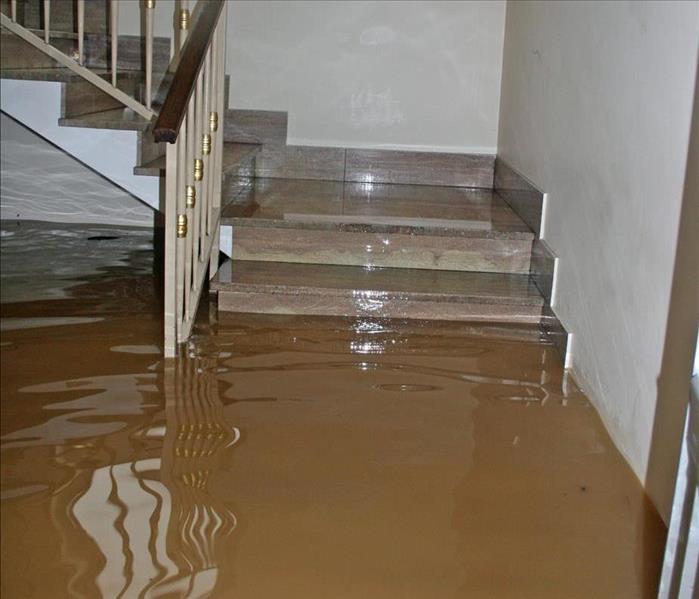 If your home has experienced flooding in Manda, TX, it's important to act right away.
If your home has experienced flooding in Manda, TX, it's important to act right away.
Did You Know There Are Some Things NOT To Do For The Safety Of You And Your Family?
If your home has experienced flooding in Manda, TX, it's important to act right away. You know that you need to call your insurance company and that they will recommend a water damage restoration service that can help with your home repairs.
1. Do NOT Use a Vacuum
You know it's important to remove standing water quickly in order to prevent damage. However, a regular vacuum cleaner is NOT the right appliance for the job. A shop vacuum that is intended for water may be used, but a vacuum that is meant for picking up dirt, even if it's a steam cleaner, is not safe to use to remove standing water in your home.
2. Do NOT Operate Appliances
A broken pipe that has led to flooding can compromise the electrical system in your home. Do NOT use the television, washer and dryer, or plug in other small appliances like heaters or hair dryers until a professional has determined that it is safe to do so.
3. Do NOT Leave Things on the Floor
Once you can safely enter the space that is flooded, do NOT leave items on the floor. Books and magazines can bleed color onto carpets and flooring. Rugs retain moisture and should be removed quickly. If possible, remove, or at least elevate, furniture to allow air to flow freely beneath the pieces.
4. Do NOT Take Risks
Cleanup from a broken pipe is important to prevent long-term damage, but doing so is not worth risking your health and safety. Do NOT enter rooms where the ceiling is sagging or where standing water is touching electrical appliances. Do not turn on lights, especially if water is leaking from the ceiling.
Flooding in your home is overwhelming, whether caused by a broken pipe or a natural disaster. Call for help and always take reasonable precautions to protect yourself from harm.
5 Ways for a Business To Use Less Water
2/10/2021 (Permalink)
 Annual plumbing inspections can identify issues.
Annual plumbing inspections can identify issues.
Five Ways To Maximize The Efficiency Of Water Use And Save Money
Overuse and waste are the most significant water issues at commercial properties located in Cele, TX. Inefficient bathroom fixtures, irrigation and cooling systems can drive up water bills at any building.
1. Switch To Low-Flow Fixtures
Old commercial toilets use anywhere from three to seven gallons of water per flush. Consider a water upgrade to low-flow toilets that use anywhere from 1.28 to 1.6 gallons per flush or urinals that use just 0.05 gpf or are waterless.
2. Adjust the Irrigation System
From installing sensors that detect rain or measure soil moisture to scheduling sprinklers to water less often for longer periods of time, there are several ways to reduce outdoor water waste. Irrigation accounts for a significant percentage of water usage at commercial properties with landscaping.
3. Avoid Pipe Breaks and Leaks
Annual plumbing inspections can identify issues such as old or worn pipes or corrosion build-up that can lead to water issues and leaks. A hidden leak can cause water bills to spike, and usage will not decline until the problem is fixed.
4. Maximize Cooling Tower Efficiency
Evaporation is a primary source of water use in buildings with cooling towers. Building owners may want to mix gray and potable water or otherwise recycle water to lower usage.
5. Reduce Water Booster Pressure
Buildings with more than a few floors may rely on water boosters to pump water up to higher stories. Try turning down the settings to conserve energy and water while lowering pipe pressure that could lead to breaks and water damage.
These measures may prevent common water issues at a commercial building in Cele, TX. A property owner or manager may be able to make these upgrades with small initial investments that pay off over time and reduce risks of damage.
How To Repair Your Leaking Faucet
12/29/2020 (Permalink)
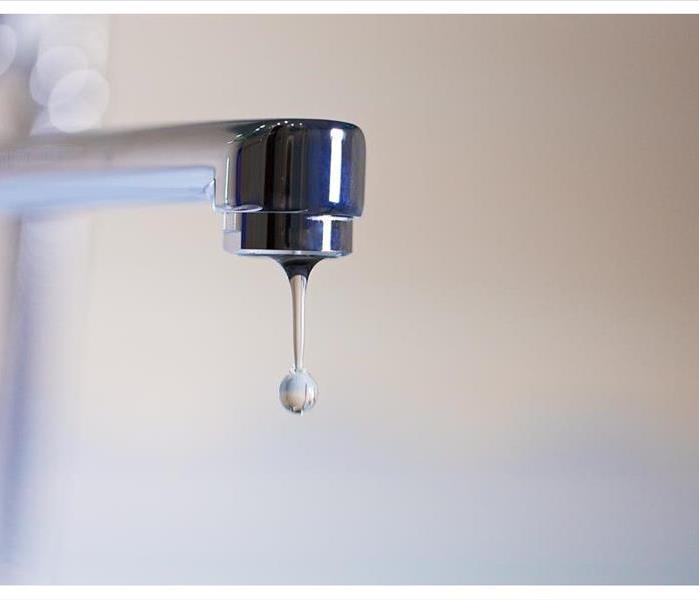 You should thus fix a leaking faucet immediately
You should thus fix a leaking faucet immediately
How To Repair Your Leaking Faucet
It is easy to ignore a leaking faucet in your New Sweden, TX, home. While it may not seem like a big deal, over time the dripping faucet could cause your water bill to surge. If the leak worsens while you are out of your house, the water could even spill over into your kitchen or bathroom.
You should thus fix a leaking faucet immediately. Start by turning off the water supply to your faucet. Next, plug the drain closed.
From there, the process differs slightly depending on what type of faucet you have. The four main kinds of faucets are:
- Cartridge
- Ceramic-Disk
- Compression
- Ball
Cartridge Faucet
Cartridge, ceramic-disk and ball faucets each feature one handle that you move left or right to change the water temperature. As its name implies, a cartridge faucet has a cartridge along with a decorative cap. To fix this leaking faucet, remove the cap and retaining clip and pull the cartridge so it stands straight. You should then be able to remove the spout and replace the O-rings.
Ceramic-Disk Faucet
You can identify a ceramic-disk faucet by its ceramic cylinder. To fix this type of faucet, remove the cap and cylinder. Take off the neoprene seals before soaking the cylinder openings in white vinegar. You may want to replace the seals, as well.
Ball Faucet
A ball faucet includes a ball bearing. Fixing this faucet requires a special kit that you can buy in a hardware store. Take apart the faucet and use the kit to replace the cam washers, springs and valve seats.
Compression Faucet
Unlike the above faucets, a compression faucet has separate handles for hot and cold water. To repair this leaking faucet, remove the handles and nut to get to the O-ring and seat washer. Simply replacing the seat washer should fix the problem.
If you follow the above steps, you should have a fixed leak in no time. This will save you money on your water bill and limit your need for emergency cleanup services in the future.
How to Repair a Burst Pipe
10/7/2020 (Permalink)
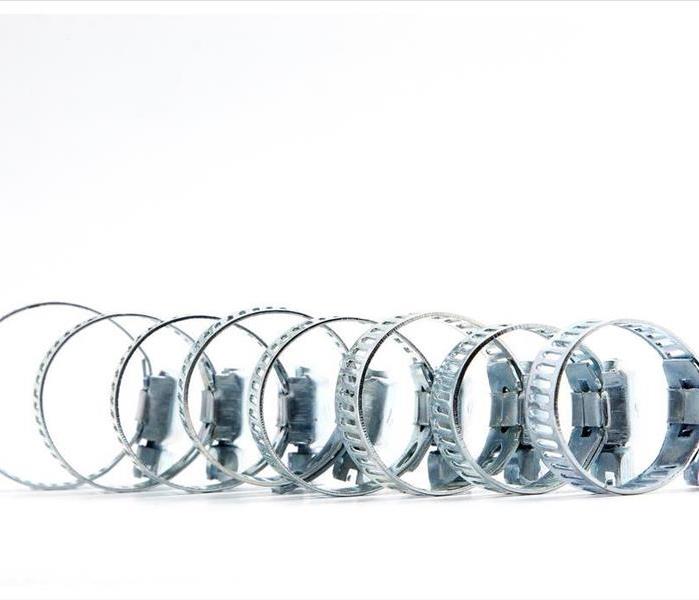 Fix a broken pipe by using metal clamps
Fix a broken pipe by using metal clamps
Bursting pipes can cause a lot of damage in a short amount of time, making them a scary issue for many homeowners. If your home in New Sweden, TX, is experiencing a pipe burst, chances are you will need to call a plumber to help resolve the issue. In the meantime, you can secure the leak using the following technique.
Fix Broken Pipe Using a Clamp and Sleeve
A clamp and sleeve kit can provide a temporary patch to stop the leak while you wait for remediation experts to arrive. Patch your bursting pipes using the following technique:
- Shut off the main water line. Use a metallic file or steel wool to smoothen any rough areas around the damaged section of pipe.
- Position the rubber sleeve so that it is centered over the burst. The clamp's seam should be facing the opposite direction of the break.
- Position the metal clamps around the rubber sleeve. Use a screwdriver to tighten the clamps.
- Reopen the water supply to the pipe. Watch carefully for any leaks.
The above technique should temporarily solve the issue while you wait for the plumber to arrive. If it doesn't fix the leak, simply repeat the process and reposition the clamp until it solves the issue.
Dry the Water
As soon as you stop the leak, you need to start drying the water. Standing water can quickly cause a lot of secondary damage, such as mold growth, so it's important that you act quickly. If the leak was small, you can resolve the issue by mopping up the water with a towel. Larger leaks that create a lot of water damage likely require professional assistance.
It's important that you take immediate action to fix bursting pipes as soon as you discover it. The subsequent water damage can wreak havoc on your home and cause several subsequent issues. Contact water remediation experts for help assisting with damage cleanup.
6 Ways To Prevent Water Damage on Your Construction Site
8/21/2020 (Permalink)
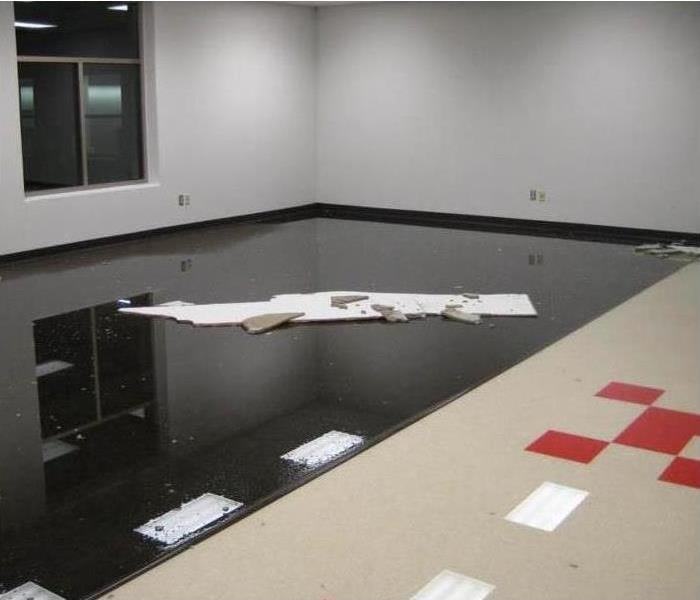 Commercial water damage in Cele, TX
Commercial water damage in Cele, TX
Consider The Following Six Tips To Avoid Water Damage In Your Construction Site
Commercial property development is not without its headaches. From a basic water pipe repair to thorough flooding of the property, there are plenty of reasons you may have to call a water mitigation company in Cele, TX before you even open for business. To avoid water damage at your construction site, consider the following six tips.
1. Have On-Site Manager Sign Off on Plumbing
The last thing most business owners and project managers want to deal with is a broken pipe. To avoid such a disaster, you may want to make sure the on-site manager signs off on the plumbing before activating systems. While the extra sign-off may not be needed to pass inspection, it is a way of double-checking work.
2. Waterproof Susceptible Areas
Can you imagine walking into a new structure and seeing the stairwells or elevator shafts flooded? During construction, these open areas are among the most susceptible to external flooding. To prevent such catastrophes, make sure you have waterproofing measures in place, like tarps.
3. Only Allow Authorized Contractors to Place Sytems Into Service
It is essential to install piping and safety systems, such as fire suppression sprinklers, correctly. Do not trust these systems to just any contractor. If you want to avoid a water pipe repair, then only trust authorized contractors to place such systems into service.
4. Charge Zone-by-Zone
Many companies make the mistake of charging the entire plumbing system at once. If you pressurize the whole system, you risk multiple leaks and significant water damage. Instead, charge the plumbing zone-by-zone, inspecting as you go.
5. Verify Piping Installation
While it may seem unlikely, mistakes happen. When piping is installed, double-check that it matches the building plans and needs.
6. Grade the Soil
The soil around the building should be graded away from the project. If the grade is not adequate, you risk water flowing towards the building and flooding it.
The best way to avoid a water pipe repair or significant water damage during construction is to take your time and prepare. The above steps can help, but if your planning fails, you can always call a mediation company.
What if a Toilet Overflows in Your Home?
6/4/2020 (Permalink)
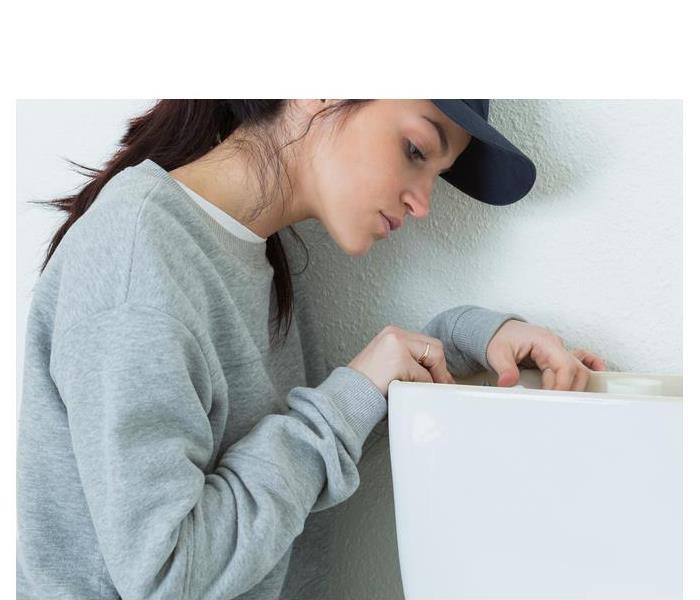 Open the tank and raise the float so that the inflow valve shuts off
Open the tank and raise the float so that the inflow valve shuts off
The world could be said to have entered the modern era around 1900 since this was when average homeowners started seeing flushing toilets become widespread for individual residences. Solutions to handling sewage before indoor toilets were inconvenient at best and frequently a public health disaster.
Unfortunately, when commodes don’t work right, it can feel like a throwback to the 19th century, potentially leaving you with widespread sewer damage in your home – and an unholy mess to face. Knowing how to handle it will make your life easier.
What Are the Types of Damage?
The sewer damage to your home will depend on the category of water damage:
- Category 1 is clean water with no waste.
- Category 2 is grey water with urine but no feces.
- Category 3 is black water with fecal material.
A flooded toilet with clean water will at least present no danger of contamination, although if it soaks into carpet, wood, or drywall, you may need professional help. Category two or three will almost always require an expert to disinfect the impacted areas and inspect for hidden water damage.
What Should You Do if It Happens?
First off, stop the overflow! Open the tank and raise the float so that the inflow valve shuts off. If necessary, turn off the water to the toilet. Remove standing water as fast as possible; if it’s a small amount of clean water and you remove it immediately you may not need to do anything else. If there’s sewer damage, excessive amounts or contaminated water, you’ll almost certainly need to consult with a local restoration company experienced in dealing with serious water damage.
Who’s Responsible for the Clean-Up?
In most cases, you’re the lucky one who deals with the mess. Unless your sewage company can be shown to have negligently caused a serious plumbing issue, the homeowner is responsible in Pflugerville, TX. In a multi-family unit, your landlord may share responsibility or be expected to handle the problem if the sewer line is shown to have serious issues. At the least, the immediate mess is always your problem.
Common Pipe Noises and When To Worry
5/26/2020 (Permalink)
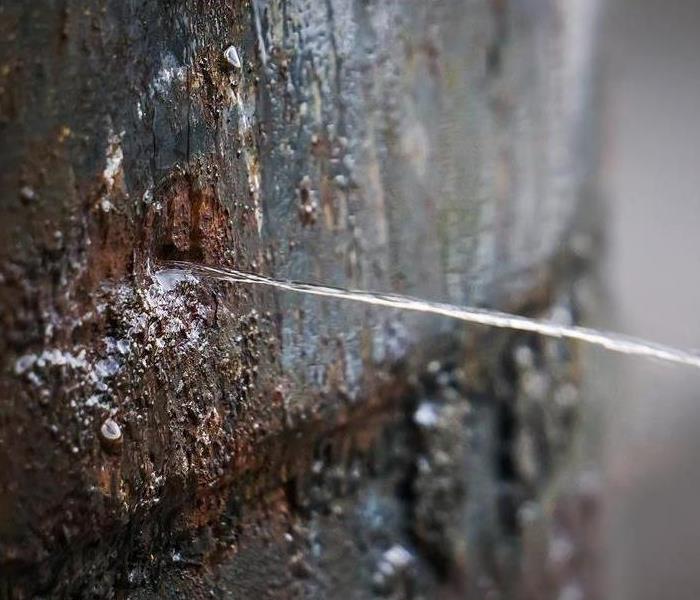 While not every noise coming from your plumbing will indicate a pipe break, being aware of those sounds that do often relate to problems is wise.
While not every noise coming from your plumbing will indicate a pipe break, being aware of those sounds that do often relate to problems is wise.
Many homeowners worry about the potential costs associated with a pipe break. However, few people concern themselves with understanding the noises that can give them a warning sign of potential problems. If water damage worries you, then take the time to understand the three sounds that may help you predict an expensive issue.
Whistling or hissing
Banging
Running water
Whistling or Hissing
Have you ever stood at a faucet in your home and heard hissing or whistling when you turn it on? Does the sound also happen when you shut it off? Either sound indicates an obstruction in the pipe. While the obstacle may not yet be enough to block the flow of water, it may get to that point rapidly. Clearing the buildup is crucial, especially since increased pressure can lead to a pipe burst.
Banging
Banging sounds often referred to as water hammering, may involve air in the line, which can come from an existing leak. You may hear the thudding or banging when turning off faucets or flushing toilets. The constant abuse of the water lines can cause a pipe break, especially the longer the problem persists.
Running Water
The sound of running water, whether a slow, steady drip or rushing, is a noise that requires immediate intervention. Contact a water mitigation company in Austin, TX, to assess the property because they likely need to fix broken pipe connections. However, before calling any company, be sure to turn off the main water supply valve for your home.
While not every noise coming from your plumbing will indicate a pipe break, being aware of those sounds that do often relate to problems is wise. Whistling, banging, and running water sounds are common signs of blockages and other water line damage. Contact a professional plumber or mitigation service in your area for an assessment of your property and to perform any necessary repairs.
What Does Water Damage Restoration Entail?
5/18/2020 (Permalink)
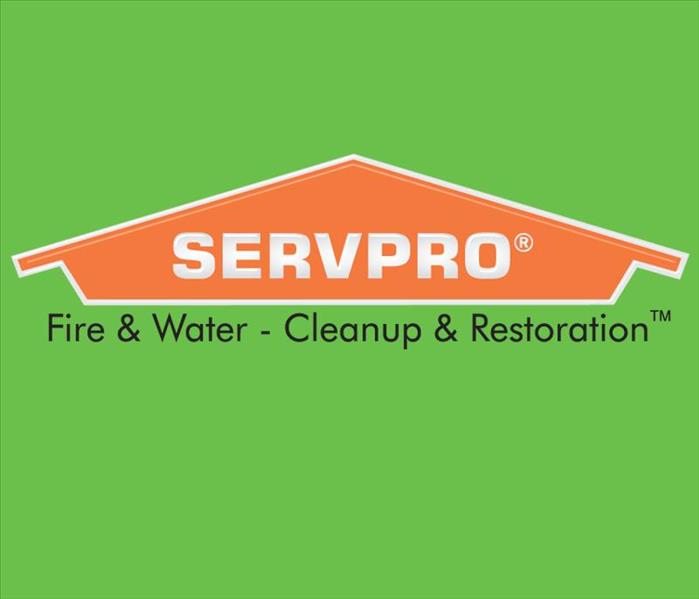 A pipe burst can produce clean or dirty water depending on the type of pipe.
A pipe burst can produce clean or dirty water depending on the type of pipe.
Some amount of water damage is unavoidable in the wake of a home flood that has resulted from a pipe burst or another issue. Immediate steps must be taken to stop the water and to begin the restoration process. So, what should you expect? First, you need to contact a team of water damage cleanup professionals. This cleanup crew will:
1. Perform a Damage Assessment
When the experts arrive on the scene they’ll begin by inspecting the damage and coming up with a plan of action. If water is still flowing into the area, they’ll stop it and also assess the safety issues such as water contamination level.
2. Extract the Standing Water
Next, the water will be extracted from the affected area with large, powerful wet/dry vacuum units. The crew can then move your belongings out of the area to guard them against further damage. Your flooring, walls, and ceilings, along with the general humidity of your home will be assessed.
3. Dry Everything
After the standing water is removed, it’s necessary to dry the affected area and its contents as much as possible. You may not realize just how much is wet; everything from flooring to drywall to furniture can suffer water damage. The professionals will use industrial-grade fans and dehumidifiers to remove all moisture. They’ll also check for signs of mold.
4. Clean and Sanitize Everything
A pipe burst can produce clean or dirty water depending on the type of pipe. Even materials that haven’t been affected by mold or dirty water can emit a foul odor and require cleaning. The professional remediation team will clean, sanitize, and remove the odor of any salvageable materials. They’ll also dispose of the unsalvageable.
5. Restore the Area and Contents
Finally, the restoration will begin on the affected area and its remaining contents. Such restoration will entail the tear-out and installation of materials such as flooring and drywall, possibly even parts of the room’s basic structure or frame.
Flooding in your Austin, TX, home can be devastating, whether from a pipe burst or water line blockage. The quicker the process begins, the less damage that will occur.
4 Reasons to Replace Polybutylene Plumbing As Soon As Possible
5/10/2020 (Permalink)
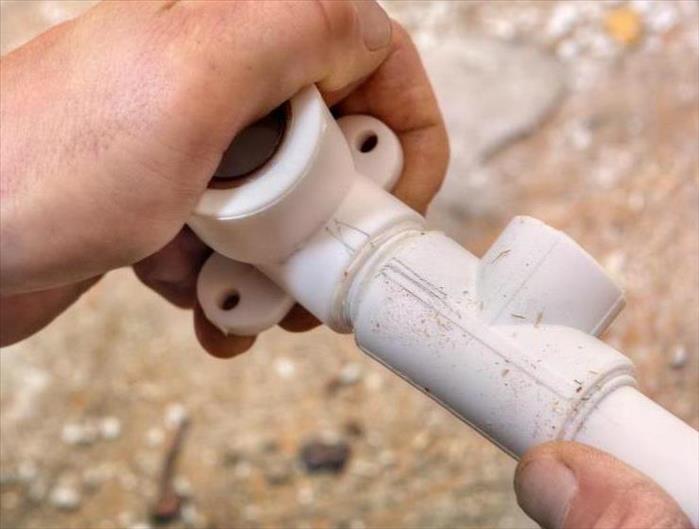 Polybutylene plumbing was once a popular choice, because it was easy to install and relatively inexpensive
Polybutylene plumbing was once a popular choice, because it was easy to install and relatively inexpensive
4 Reasons to Replace Polybutylene Plumbing As Soon As Possible
Polybutylene plumbing was once a popular choice, because it was easy to install and relatively inexpensive. However, it was discovered that these pipes came with a myriad of problems. The following are a few reasons why you should replace them if they are used in your New Sweden, TX, building.
1. They Are Old
One reason is simply that they are aging. These types of pipes were installed between the 1970s and 1990s, which means that they are reaching the end of their life. You should install new plumbing before this becomes an issue.
2. They Can Contaminate Your Water
As polybutylene pipes break down over time, they can leach chemicals into the water, contributing to contamination. This can be especially troublesome if this water is used for drinking or in food preparation.
3. They Break Easily
Another reason to have these pipes replaced is that they can break more easily than other types of plumbing. The chemicals used to treat your water can have a negative effect on the material of these pipes. It can cause them to break and crack which can result in large amounts of water damage to your building or the surrounding area.
4. They Cannot Be Repaired
Because this type of plumbing is no longer approved under United States building codes, repairing them is not an option. They will eventually wear down to the point that they break and will likely cause many problems for your business. The best option is to install new plumbing as soon as possible to prevent this.
If you experience water damage in your building due to polybutylene piping, a cleanup and restoration company can help perform mitigation to keep secondary damage to a minimum. They can remove the water from your building and salvage a wide range of belongings. They can also perform any necessary repairs to return your building to its previous condition.
Causes of a Leaky Toilet
2/17/2020 (Permalink)
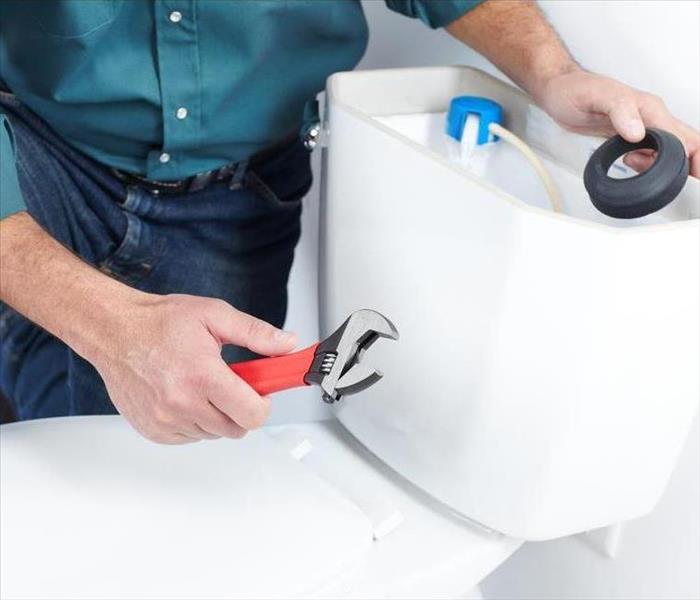 Sometimes a leak is quickly resolved with standard household tools.
Sometimes a leak is quickly resolved with standard household tools.
A leaking toilet is a common problem in a home, and it does not always require the skilled hands of plumbing professionals in Austin, TX. Sometimes a leak is quickly resolved with standard household tools. However, before you can fix a leak, you must know where the leak is coming from. There are at least four likely sources for a leaky toilet.
Loose supply line or faulty shutoff valve
Cracked tank
Loose Bolts
Dry wax ring
Loose Supply Line or Faulty Shutoff Valve
One of the first things you should check when experiencing this type of bathroom leak is the supply line and the shutoff valve. It is not uncommon for these lines to loosen over time, causing a small leak. Also, the water shutoff valve can age and become less effective over time.
Cracked Tank
Next, check around the outside of the tank for any moisture or condensation. If you find any, then dry the area and wait a few minutes. If the moisture buildup reappears, then you might have a small crack in the tank that is causing your leaking toilet. If it is a crack, depending on the extent of the damage, you might need to replace the toilet.
Loose Bolts
If you notice pooling around the base of the toilet, then you might have loose bolts. The floor bolts are meant to hold the toilet tight against the wax ring underneath, preventing waste fumes and leaks. Check the bolts and try tightening those that feel loose. Then dry the area and see if water reappears.
Dry Wax Ring
If water reappears after tightening the bolts, then you likely have a dry wax ring. Unfortunately, this means that you will need to remove the toilet and replace the ring.
A leaking toilet is not always a sign of more worrisome issues. Sometimes it is just a loose element and nothing more. However, if you are concerned, then you can reach out to a plumbing specialist for an assessment.
Mitigating Water Damage After a Water Heater Fails
2/11/2020 (Permalink)
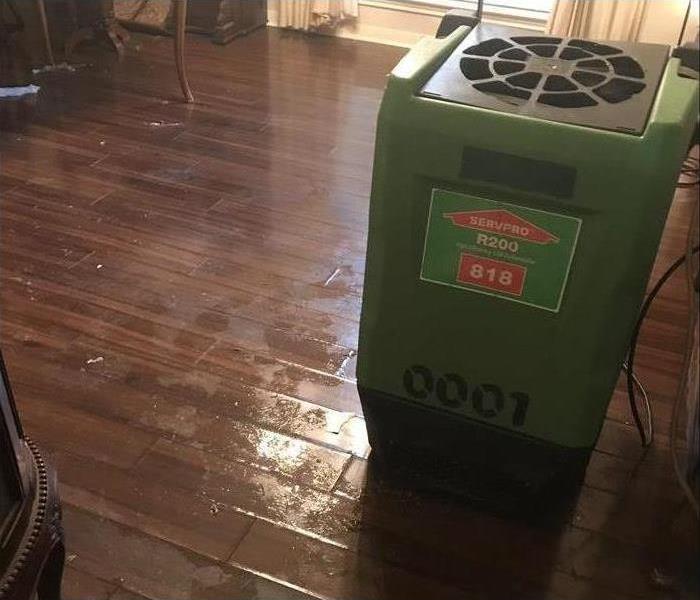 Mitigating water damage in a Cele, TX home
Mitigating water damage in a Cele, TX home
Mitigating Water Damage After a Water Heater Fails
A failed or leaking water heater can cause significant damage to your property, especially if it had gone unnoticed. These devices can lead to major flooding in homes and will probably require a mitigation and restoration company in Cele, TX, to clean and repair your system and property. Any company you call will typically follow the same procedure.
Shut off water supply
Remove equipment and water
Dehumidify the area
Remove damage
Restore property
Shut Off Water Supply
After experiencing a failed water heater, you will need to address the situation quickly to avoid significant damage. Before calling for help, you should find the water shutoff valve to stop the continued flow of water from the heater.
Remove Equipment and Water
Once the restoration company arrives, they might first assess the damage to your property before removing the broken water heater and extracting the excess water. To remove the flood, they will typically use shop vacs, pumps and possibly special trucks with built-in suction pumps, depending on the depth of the flooding.
Dehumidify the Area
After the leaking water heater and the flood are removed, the team will get to work drying and dehumidifying the affected space. It is necessary to make sure that the structure of the home is completely dry before getting to work on any repairs.
Remove Damage
While the space is drying, the restoration company will probably be removing damaged items as well as any structural damage like drywall or insulation. The removal of drywall is sometimes necessary, especially with significant flooding, because the wall cavities could have been exposed to excessive moisture, which may lead to mold.
Restore Property
Once the area is dry and all damage has been removed, the company you hired will begin restoring the property. Restoration companies are experts in returning your home to pre-disaster conditions, which means you will see no evidence of flood when they are done.
While a leaking water heater may not lead to a full-blown disaster, a failed tank can. If you experience such a failure, then seeking out a restoration professional might be your best option.
3 Ways to Locate a Leak in Your Shower
1/29/2020 (Permalink)
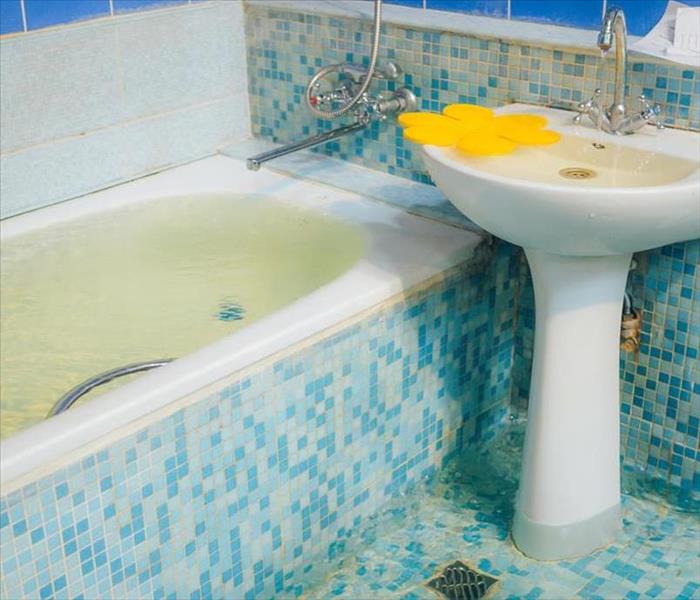 Inspecting the floor around the shower or tub, the room beneath, and the basin itself can help you determine if a bathtub leak is a problem.
Inspecting the floor around the shower or tub, the room beneath, and the basin itself can help you determine if a bathtub leak is a problem.
Repairing a shower or bathtub can be costly. That's why it’s important to locate a shower or bathtub leak in your Austin, TX, as quickly as possible. Not only can fixing a leak quickly, save you money, but you may be able to prevent further damage to your home. There are a few things you can look for if you believe there may be a leak in your bathroom.
1. Inspect the Surrounding Floor
One of the first things to do when suspect there may be a leak is to inspect the surrounding floor. Often water damage can be seen in loose grout, missing calk, softwood, discolored tile, and bubbling or peeling paint. If you see these signs it’s best to contact a water damage restoration professional as quickly as possible.
2. Inspect the Ceiling of the Room Beneath
Locating a shower or bathtub leak can be helped by looking at the ceiling of the room beneath. Often leaking water can soak through and cause discoloration, sagging material, or bubbling paint. Not only can these signs be taken as a sign of a leak, but can also show the path of water travel to help locate the leak’s source.
3. Inspect the Shower Compartment
Another way to determine if you have a shower pan leak is to inspect the bathing stall itself. Look for areas of loose or missing grout, missing caulking, or obvious cracks. You may also take note of any area where the stall or back-splash panel seems to be coming away from the wall. These areas along with floor or wall discoloration could indicate a leak.
Inspecting the floor around the shower or tub, the room beneath, and the basin itself can help you determine if a bathtub leak is a problem in your home. It may be helpful to look for loose or damaged materials. Remember, if you do find damage it’s important to contact a professional for any repair needs.
Keep Water Damage to a Minimum With a Fast Response
1/28/2020 (Permalink)
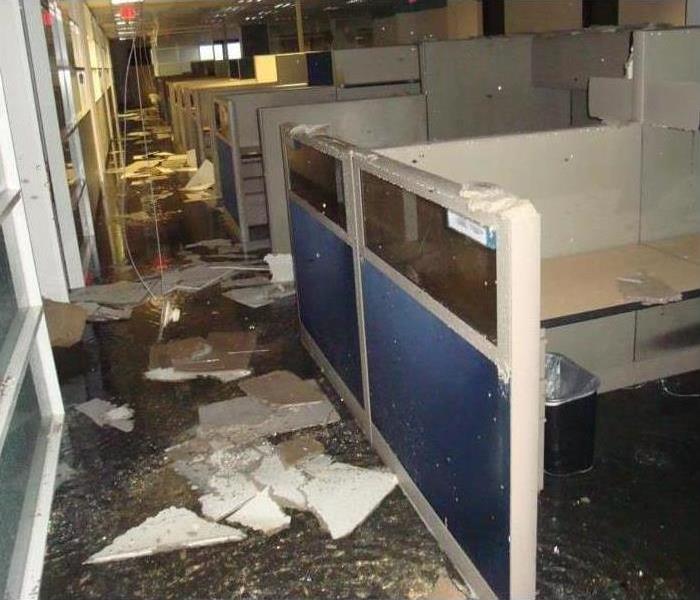 Office water damage in New Sweden, TX
Office water damage in New Sweden, TX
When your commercial property experiences a case of bursting pipes, you want to reduce expenses and damages as much as possible. You also want to keep a business interruption to a minimum. One key to this is finding specialists in water damage who are Faster to any size disaster. Whether it is plumbing problems or a flood from a storm, a fast response is crucial. When trained and certified technicians arrive on the scene in less than four hours they start with an initial inspection and damage assessment and then move on to water removal. Water, whether it is clean or contaminated, can ruin carpeting, flooring, and furnishings in a matter of hours.
Complete Water Restoration
Every water situation is unique. Unwanted water comes from storms, broken appliances, overflowing toilets and sinks, and sewage backups. To fix broken pipe you need workers who have experienced these occasions before. The restoration process involves the following steps:
- Water removal and extraction
- Drying and dehumidification
- Cleaning and sanitizing
- Restoration of damaged materials
It's important to have all water removed from bursting pipes and other sources. This prevents additional damage to materials and doesn't give mold a chance to gain a foothold. Trained technicians will monitor the drying process and measure the amount of humidity in the building.
Rapid Water Restoration
It's not always during business hours when water damage New Sweden, TX, strikes. In fact, it often happens in the middle of a night or on a weekend. Therefore, it's important to call a remediation team that will be there quickly no matter the time of day or night. Within minutes, water can spread throughout a building and seep into carpeting and wood. Drywall begins to crack and degrade in hours, and furniture begins to swell and crack. Water removal, if done quickly, saves materials and reduces the overall expense of the cleanup. Tackling bursting pipes is a job best left to the professionals in water restoration.
Steps You Should Take if Your Basement Floods
1/21/2020 (Permalink)
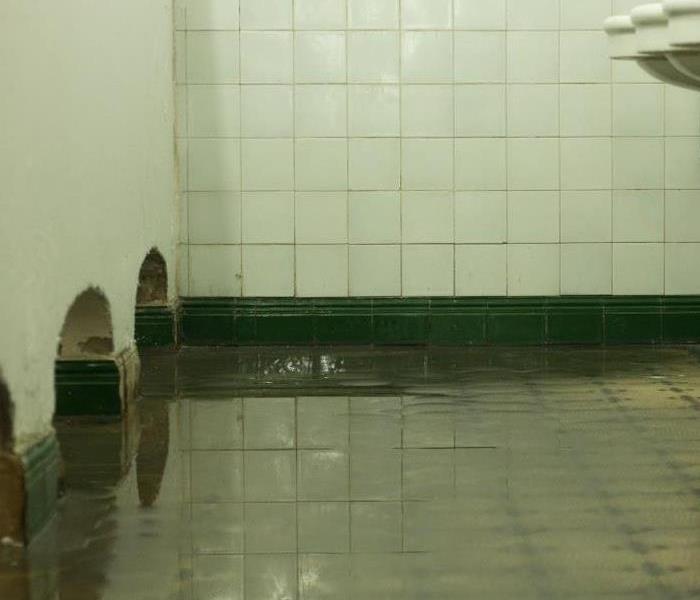 Water can make its water into lower levels of a house through cracks in the foundation.
Water can make its water into lower levels of a house through cracks in the foundation.
If you walk down to the basement in your Austin, TX, home, water is one of the last things you want to see. Unfortunately, flooding is not uncommon in this area of a house. Water can get into basements in many ways. Luckily, there are effective measures you can take to clean it up and get your home back to normal.
Causes of Basement Flooding
Water can make its water into lower levels of a house through cracks in the foundation. Because the basement is located partially or entirely beneath the surface, groundwater could be right outside. Foundation problems can allow water to seep inside. Other typical ways a basement flood starts include:
Sewer backup
Broken water heater
Leaky or broken pipe
Poor drainage or insufficient rain gutters
Get Out
If you spot water in your basement, stop the water source if possible. Then, shut off the electricity and get out of the house. If it's safe to do so, move materials out of the water and to higher ground. However, if black water has gotten into the home, never get near it.
Make the Calls
When flooding occurs at home, you should immediately call city utility crews if the main water line or sewer backup caused the issue. Next, get in touch with a professional flood cleanup team to remove the water. You should next contact your homeowner's insurance to discuss filing a claim.
Let the Pros Take Over
If there is no black water in the basement, and if the flooding is small, grab a wet vacuum and extract the water. You can also set wet items out to dry. For more widespread or dangerous flooding, let the professionals handle it. Specialists will remove the water, thoroughly dry the area and sanitize all affected parts of the basement. Crew members can also tear out ruined materials and take care of pipe repair.
The effects of flooding can be devastating. You can minimize the damage by following these steps and getting help from a professional company.
4 Causes of Crawl Space Flooding in Your Home
1/20/2020 (Permalink)
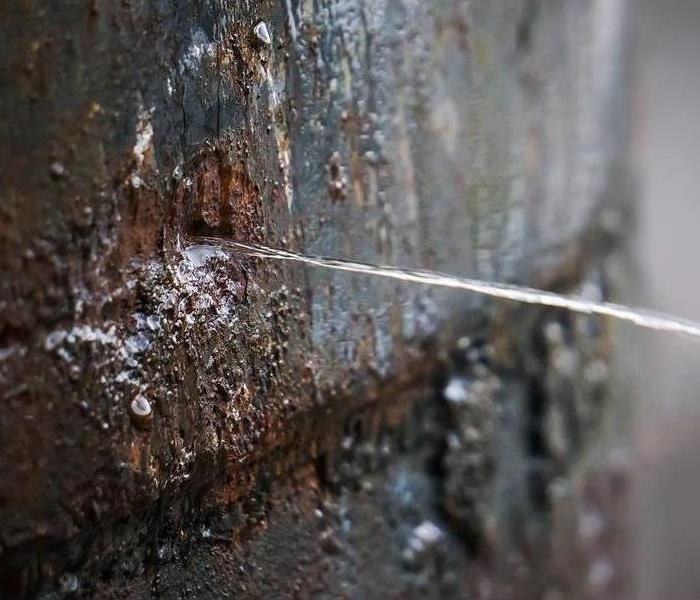 If a pipe cracks or bursts in your home, the water will ultimately flow into the lowest space in your house.
If a pipe cracks or bursts in your home, the water will ultimately flow into the lowest space in your house.
A wet crawl space may seem like a minor issue. However, if left untreated, it could lead to mold growth in your Austin, TX, home. A persistent flow of water in the crawl space could also spread to the main part of your house.
That is why you should regularly check this part of your home for signs of excess water. You should also take steps to prevent these common causes of crawl space flooding.
Downspout Problems
A downspout aimed too close to your home can cause water buildup in your crawl space. Point your downspout away from the foundation of your home and add a splash block to guide the water away from your property.
Over-Watered Flower Beds
You may not think of your flower bed as a potential cause of a wet crawl space. But overwatering of your plants does not only cause them to die. It can also lead to a flood in your home. To prevent this problem, put base layers into your flowerbeds to catch excess water.
Poor Slope Grading
If the landscape outside your home is not sloped properly, water will flow back into the crawl space. The slope should be six to eight inches away from the walls of the foundation. Winter snow and ice can change the sloping, so be sure to check the grading each spring.
Broken Water Lines
If a pipe cracks or bursts in your home, the water will ultimately flow into the lowest space in your house. Keep your eye out for any obvious puddles or wet areas on your property, as these may point you to the location of the ruptured pipe.
If you can't find the leaky pipe or the cause of your wet crawl space, emergency restoration professionals can help. They will not only locate and stop the source of the water, but they can also clean and dry any damaged items or structures.
What To Do When a Flood Is Headed Your Way
11/5/2019 (Permalink)
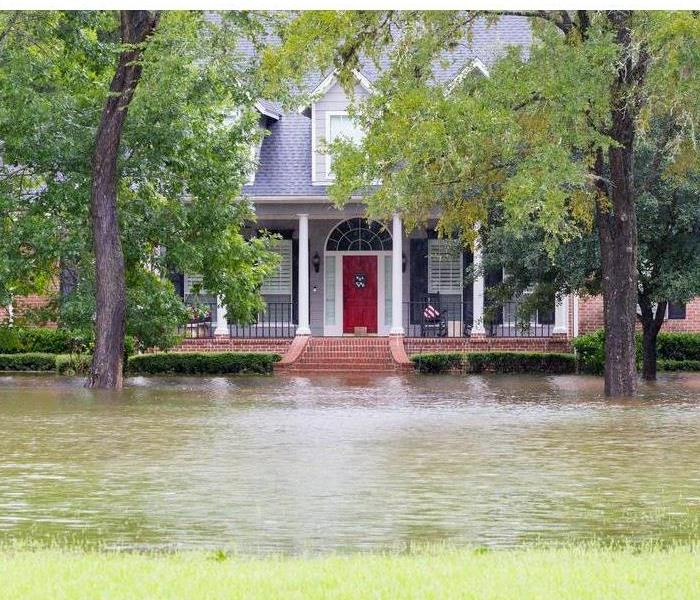 Storms can move quickly and bring devastating consequences.
Storms can move quickly and bring devastating consequences.
When a storm is headed your way in Pflugerville, TX, you should do all you can to prepare. Some storms bring the threat of a water deluge, high winds, and hail damage. Floodwater can cause a lot of destruction, and in extreme cases, it can leave you stranded in your home. The harm to your property can be extensive, and you will need storm damage repair experts to get your home back to normal. However, it's important to be organized and do everything you can to get ready.
Assemble an Emergency Kit
Extensive water damage can make it difficult to leave your house, particularly when you are in a flooded building. You should have an emergency kit ready in case you can't get out of your home for a few days. The kit should include articles for basic survival, as well as items to call for help when needed. Here are some necessary things to pack in your emergency kit:
Clean water
Flashlight
Blankets
Snacks
Whistle
Phone charger
You can order an emergency flood kit online if you don't want to build one yourself. Make sure you also have an up-to-date first aid kit at your residence.
Check Forecasts Frequently
Storm paths and severity can change quickly and often. When gale forces are headed your way, check the forecast updates regularly, especially as the storm gets closer. This should help determine the flood water risks.
Evacuate If Necessary
Your home is important, but your safety should be your number one priority. If authorities recommend evacuation, don't hesitate to leave the area immediately. Traffic often slows to a crawl when everybody attempts to leave at once.
Storms can move quickly and bring devastating consequences. Your best bet is to plan in advance and prepare for flood water. An emergency kit can be helpful if you are stranded, but be sure to check the forecasts regularly and evacuate if your safety is in question.
Ready to Dry
7/1/2019 (Permalink)
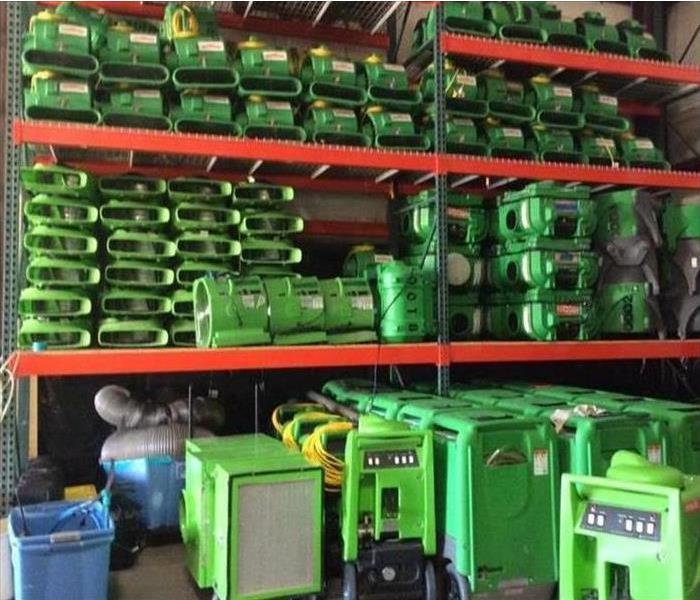 Here's a peek at some of our drying equipment.
Here's a peek at some of our drying equipment.
When customers in our area suffer a water damage, SERVPRO of Pflugerville is ready to help dry out their property, and get it back to its pre-damaged condition.
Within our franchise alone, we have over two hundred pieces of drying equipment. This inventory allows us to take on any commercial or residential loss in the greater Austin area.
Our trucks are meticulously stocked with any and all necessary equipment to restore your home or business in a timely manner, and we are at your disposal 24 hours a day, 7 days a week, 365 days a year.
If our equipment is not enough to restore your property, we have a network of 1700 franchises ready to mobilize and help us make it "Like it never even happened."
Call SERVPRO of Pflugerville whenever you experience a water loss, and we'd love to serve you in restoring your property.
New Sweden Residents: We Specialize in Flooded Basement Cleanup and Restoration!
1/10/2018 (Permalink)
A basement can flood at any time, although flooding most often occurs during heavy rainfall. Basements are inherently prone to flooding because they are the lowest level of a building and are normally built partly or entirely below ground level. There are a number of reasons why your New Sweden basement could flood, including:
A blocked or failed sewer lateral pipe
Heavy rain causes surface water to pool around your home
Storm sewer backup
Sanitary sewer backup
Foundation drainage failure
Water supply-line break or hot-water tank failure
And many more
Have Questions about Basement Flooding?
Call Today - (512) 990-4776
If flood water is not handled quickly and properly, it can jeopardize your health and safety, and cause severe damage to your home’s structure. Remember, the longer you wait, the worse the problem will get.
The bottom line: a flooded basement can jeopardize your health, safety, and your home’s integrity. It’s worth making a call to SERVPRO of Pflugerville and let our trained, professional crews handle the situation safely and correctly. We have earned the trust of hundreds of homeowners, business owners, and property professionals.
We are Flooded Basement Specialists:
We are Available 24 hours/7 days per week
We’re a Preferred Vendor to many National Insurance Companies
We Bill The Insurance Directly – One Less Thing For You To Worry About
Our Technicians are Highly-Trained in Water Restoration Techniques
We use s500 IICRC Restoration Standards
Advanced Inspection and Extraction Equipment
Faster to your Round Rock Water Damage Event
9/1/2017 (Permalink)
Flooding and water emergencies don’t wait for regular business hours and neither do we. SERVPRO of Pflugerville provides emergency cleaning and restoration services 24 hours a day, 7 days a week—including all holidays.
Faster To Any Size Disaster
Flooding and water damage is very invasive. Water quickly spreads throughout your home and gets absorbed into floors, walls, furniture, and more. SERVPRO of Pflugerville arrives quickly and starts the water extraction process almost immediately. This immediate response helps to minimize the damage and the cleaning and restoration costs.
Need Emergency Service? Call Us 24/7 – (512) 990-4776
Water Damage Timeline
Within Minutes
- Water quickly spreads throughout your property, saturating everything in its path.
- Water is absorbed into walls, floors, upholstery, and belongings.
- Furniture finishes may bleed, causing permanent staining on carpets.
- Photographs, books, and other paper goods start to swell and warp.
Hours 1 - 24:
- Drywall begins to swell and break down.
- Metal surfaces begin to tarnish.
- Furniture begins to swell and crack.
- Dyes and inks from cloth and paper goods spread and stain.
- A musty odor appears.
48 Hours to 1 Week:
- Mold and mildew may grow and spread.
- Doors, windows, and studs swell and warp.
- Metal begins to rust and corrode.
- Furniture warps and shows signs of mold.
- Paint begins to blister.
- Wood flooring swells and warps.
- Serious biohazard contamination is possible.
More Than 1 Week:
- Restoration time and cost increase dramatically; replacing contaminated materials and structural rebuilding may be extensive.
- Structural safety, mold growth, and biohazard contaminants pose serious risks to occupants.
About SERVPRO of Pflugerville
SERVPRO of Pflugerville specializes in the cleanup and restoration of residential and commercial property after a fire, smoke or water damage event. Our staff is highly trained in property damage restoration. From initial and ongoing training at SERVPRO’s corporate training facility to regular IICRC-industry certification, rest assured our staff is equipped with the knowledge to restore your property.
Pflugerville 24 Hour Emergency Water Damage Service
8/17/2017 (Permalink)
SERVPRO of Pflugerville is available 24 hours a day for water emergencies, large or small. When you are dealing with water damage, immediate action is crucial. A delay of just a few hours can greatly increase the severity of the water damage.
We Answer the Phone Ready to Help Call Today - (512) 990-4776
We understand that when you call us, you may be feeling confused, stressed, and vulnerable. You need an expert to guide you through this crisis. SERVPRO of Pflugerville has the specific water damage training and experience to help you through this tough time. We specialize in water damage restoration—in fact, it's the cornerstone of our business.
What to Expect
When you call, we will ask several questions regarding your water damage emergency. These questions will help us determine what equipment and resources to bring, including how many trained SERVPRO Professionals may be needed.
Our SERVPRO Representative will ask several questions:
- Your name and contact information
- Your insurance information (if applicable)
- The street address of the water-damaged home or business
- When did the flooding or water damage occur?
- What caused the water damage (if known)?
- Is there electricity available (on-site)?
About SERVPRO of Pflugerville
SERVPRO of Pflugerville specializes in the cleanup and restoration of residential and commercial property after a fire, smoke or water damage event. Our staff is highly trained in property damage restoration. From initial and ongoing training at SERVPRO’s corporate training facility to regular IICRC-industry certification, rest assured our staff is equipped with the knowledge to restore your property.




 24/7 Emergency Service
24/7 Emergency Service






























